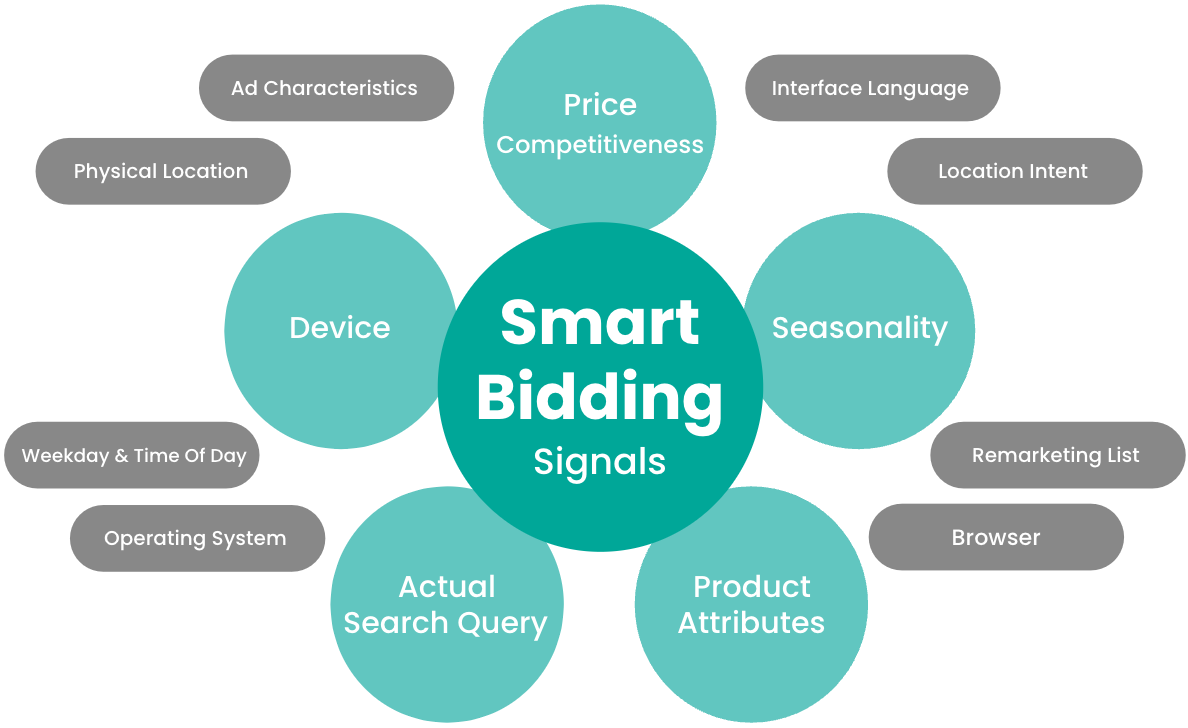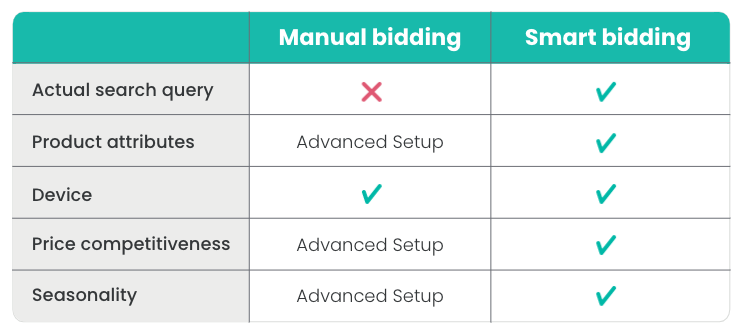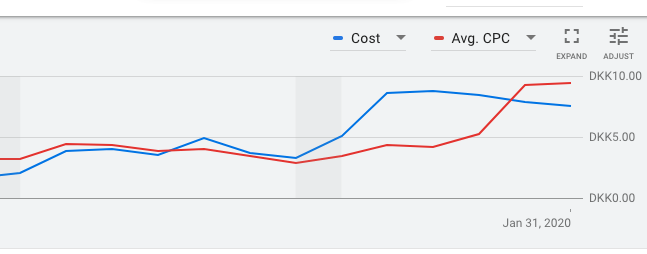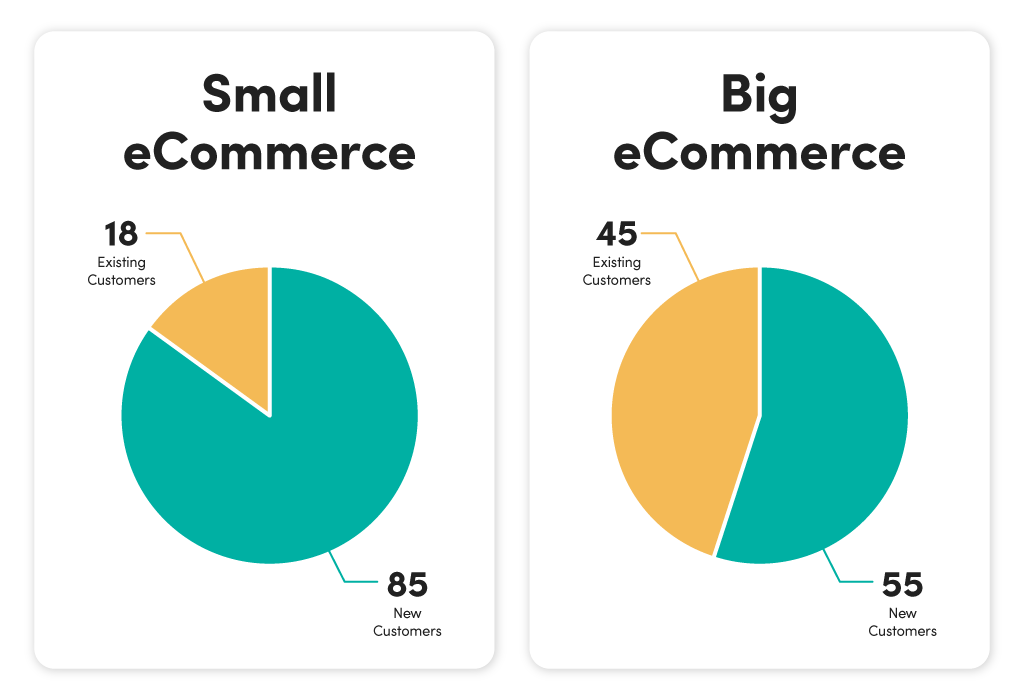Smart Bidding has been a staple in the way we run campaigns since 2020. When I was first asked to update my 2018 article on Smart Bidding, I found it said that we weren’t very optimistic about it.
Flash forward to 2024, and our internal directive since 2020 has been:
“By default, Smart Bidding must be implemented. There has to be a good reason to go manual.”
Having worked with Smart Bidding on a lot of different cases, we have found out:
- When it performs well
- When it needs help
- How we can make it better
This article covers our collective learning about these aspects, which ultimately allows us to take actions that enable Smart Bidding to perform better rather than just give up when it’s not working.
The last thing we can do, as an agency, is to say, “We’re running Smart Bidding, so there’s nothing we can do.”
So, we’ve found ways to ensure we never have to say that.
Note: I have dug deeper into overall bid strategies related to Google Ads: automated bidding vs manual bidding in another article. This article will solely focus on the Smart Bidding feature of Google Ads.
The Foundation for Smart Bidding
Your data must be:
- Correct
- Sufficient
- Stable
Let’s briefly go through these one by one:
Your tracking must be correct
I originally didn’t include this point, but enough people convinced me that it had to be in here.
You obviously need to have the correct tracking in place:
- For revenue and transactions
- Preferably from the Google Ads tag
And you must know what the revenue includes. Does it include shipping? Taxes?
Which you then correlate to the targets you have. Often, finance people will give you a ROAS target excluding tax (especially for Europe) because that’s the only way they review the numbers.
So double-check you have the right numbers in place and make periodic checks on your tracking. If you move to Smart Bidding, it will react to changes in tracking without you knowing.
Data-volume must be sufficient
I like to have at least 100 conversions a month per campaign type (Search/Shopping) before I venture into Smart Bidding. That’s not to say that this is the only time it works, but based on our cases, that’s when we typically see it working most of the time.
The more data Smart Bidding has, the more it knows about your users, which it can use to bid more effectively.
But the official guideline is at least 15 conversions in a 30-day period, and with maximize conversion value there is no minimum requirement.
Your data must be stable
This is not a requirement per se, but we have seen Smart Bidding perform the best with stable data.
So if you often have days with 0 conversions, or your AOV increases / decreases by +50%, or you have very few conversions at extremely high AOV scattered throughout the month, Smart Bidding will be less effective.
Smart Bidding Signals
I still remember the first Smart Bidding pitch I received from Google. It looked something like:
Smart Bidding is amazing because it can bid on a gazillion different signals that you as a human being couldn’t even fathom. Imagine being able to set the ideal bid based on the location, audience, browser, search term, device, AND time of day?
My first thought? Bullshit.
There isn’t enough data for 95% of the advertisers out there to make use of that combination.
Fast forward to 2024, and Smart Bidding has evolved to focus on the areas that truly make it powerful: Access to bidding on (a few) signals that we can’t access.
You can see a full list of the Smart Bidding signals below as I have chosen to rank them.
The most important bidding signals are in the middle, and the rest are used as supporting signals, depending on how strong they are:

Complete list of bidding signals
For some industries, Location will be a much stronger signal than others.
Price Competitiveness, Seasonality, and Product Attributes are solely bidding signals for Google Shopping.
The most powerful bidding signals (not including the Shopping-only signals) are without a doubt:
- Actual Search Query
- Device
- Audiences
Back in the day, we could often open accounts and just lower bidding on Mobile and make it more profitable – or tweak match types to be more profitable.
Today, you can, to a certain extent, bypass this process by simply running Smart Bidding because it will inherently bid for these factors that you originally didn’t optimize.
Which gives us all the opportunity to take our game to the next level. Not having to set manual bids on a weekly basis on a range of factors allows us to work on more strategic levels as well as close the gap on in-house teams when it comes to business insights.
For Shopping Ads it’s not fair
One of the reasons it was almost always possible to improve Standard Shopping setups by 50–300% was due to how badly manual bidding works with Shopping.
With a general Standard Shopping setup that runs manual bidding, you can only bid based on the product itself and the device. Nothing else.
This is where Smart Bidding has a massive advantage and why, in almost any case, you will get better results by using Smart Bidding for Google Shopping than trying it manually:

Now, there are a bunch of technicalities to the chart above, but that’s for another article. For now, just know that you should get much better results by running Smart Bidding with the suggestions in this article than manual bidding.
5 (13) Ways to Maximize Smart Bidding Performance
Besides the three foundational aspects that have to be in place (correct tracking, enough conversions, and stable data), when it comes to directly working with Smart Bidding, the following factors matter:
- Set correct targets
- Use portfolio bid strategies
- Use minimum and maximum bid limits
- Rethink your account structure
- Work consistently with Smart Bidding
Let’s dive in.
1) Set Appropriate Targets
When launching, or running, Smart Bidding, you should consistently review whether you have the right target in place.
You can choose a target that is:
- Equal to your historical performance
- Higher than your historical performance
- Lower than your historical performance
When you start a new portfolio, you will be able to see the ROAS target recommendation based on the historical data that Smart Bidding counts:

When you start Smart Bidding for the first time on an account, I generally recommend you set the target to the historical performance.
If your historical performance isn’t what you want it to be, you can choose a higher or lower target. Just know that this isn’t a magic pill. Setting a higher ROAS target than recommended will, in most cases, lower your impression share, resulting in less revenue.
A key aspect is setting the right targets, which takes us to the next tip: Use portfolios.
2) Portfolios Give You Better Flexibility
You can apply Smart Bidding to a group of campaigns sharing a single target (called portfolios) or on an individual campaign basis, which we routinely see a better performance with.
There are a couple of reasons for this:
- It allows Google to better balance your ROAS levels across campaigns (some campaigns can be at 400% and others at 600%, averaging out to your 500% target).
- It gives Google more data to predict performance and set bids.
- It’s easier for you to control than having 100+ different targets in large accounts.
- It allows you to set minimum and maximum bids (more on this below).
I like creating 2–3 portfolios with different ROAS targets.
Let’s say my overall account target is a 500% ROAS.
I then create three portfolios with the following targets:
- 300% Target ROAS named Revive
- 500% Target ROAS named Main
- 700% Target ROAS named Profit
This makes it easier to change the ROAS target for a specific campaign based on what you would like to achieve:
- Purpose of the Revive portfolio: One reason could be that I need to increase the exposure of a certain category, which is moving into high season. So, I move it from the 500% target to the 300% target. All of a sudden, Smart Bidding has a big campaign that can get higher bids and higher exposure.
- Purpose of the Profit portfolio: Some campaigns maximize their Top Impression Share at a high ROAS, but Smart Bidding will have a tendency to keep increasing the bids to get the most revenue possible. To avoid this, you can set a higher ROAS for these campaigns.
And, of course, your Main portfolio will be the primary one you use.
3) Always set Minimum and Maximum Bid Limits
Using portfolio bid strategies allows you to put a limit on how high (or low) Google can set your bids.
You can find them in the advanced settings in individual portfolio bid strategies:

I generally recommend setting your maximum bid limit to double or triple your avg. CPC for the campaigns.
You don’t want to needlessly limit your maximum bid, but you need Smart Bidding not to go overboard with its bids.
At the time of writing, there doesn’t seem to be any way for Smart Bidding to balance individual products or keywords against each other. If a keyword produces 1500% ROAS, then the bid for that “keyword” will increase.
Sometimes, we notice that this is too much, and that’s where the maximum bid limit will help ensure Smart Bidding doesn’t spend “stupid” money.
If you are worried about limiting Smart Bidding by doing this, then don’t be. Google will tell you when your bidding strategy is being limited by the maximum or minimum limits, so no need to be too careful here. You can always update it.
A great example of when maximum bid limits were effective was when COVID-19 was discovered in China. Below is a screenshot of a client of ours that sold surgical masks:

ROAS increased a lot, so Smart Bidding thought it should increase bids. However, it didn’t need to increase bids. We were already maximizing our Impression Share, so the increased CPCs were not needed and resulted in an unnecessarily low ROAS.
At the other end: Minimum Bid Limits
Minimum Bid Limits work by telling Google not to bid lower than the limit.
This concerns an aspect that most people don’t know about when working with Google Ads: The keyword or product is just the tip of the iceberg when it comes to segments.
A keyword or product is divided into several mini-segments based on:
- Demographic
- Search term
- Audience
- Device
- Location
And more.
As Smart Bidding uses any of these as bidding signals, it can lower its bids for any of them without you knowing that it’s actually “turning off” search terms, audiences. or devices that aren’t performing well.
With minimum bid limits, you can limit Smart Bidding to not bid lower than a set amount.
I usually recommend this to be around $0.1 to $0.2, depending on the case, but we can easily set it much higher if your avg. CPC is high.
4) Granular Account Structures Are a Thing of The Past
The idea with Smart Bidding is that the machine uses the data it gets to set the correct bids.
Many of the highly granular ways to structure Google Ads accounts in the past were meant to segment an account, so we could manually bid according to:
- Match types
- Devices
- Audiences
- Hour of the day / Day of the week
This resulted in very granular accounts that, especially in big markets (like the US), could perform really well.
But, if you are going all-in on Smart Bidding, this is not necessary. All the segmentation that you used to do to help you make better bidding decisions should be dismantled because you will not use it anymore. In fact, you can actually hinder Smart Bidding by making too granular a structure.
5) 9 Ways to Improve Smart Bidding Performance
Too many accounts are run on autopilot these days, without anything being done to optimize Smart Bidding.
That’s a mistake. In fact, the topic is so big that we dedicated an article solely to answering the question: How do you optimize Smart Bidding?
The 9 areas to optimize within Smart Bidding are:
- Increase/decrease your target
- Create different bid strategies
- Remove your ROAS target
- Change your minimum bid (temporarily)
- Change your maximum bid (rarely)
- Add Seasonality Adjustments
- Add Data Exclusions
- Change to Targeting Conversions
- Give it time
I recommend giving it a read:
9 Actions to Optimize Smart Bidding for eCommerce
Two Factors to Keep In Mind When Working with Smart Bidding
1) Smart Bidding Focuses on “Existing Customers”
The bigger your eCommerce business is, the higher the share of existing customers that can be found in the searches on Google.

When you combine this insight with the fact that you often have a better ROAS from existing customers, you can start sensing danger when using Smart Bidding under certain scenarios.
The higher you set the ROAS target in Smart Bidding, the more likely it is that Smart Bidding will decrease its bids for new customers instead of decreasing bids across the board.
This can happen in terms of bidding for your brand terms in Shopping or be directly related to retargeting audiences, demographics, or other bidding signals.
For most “smallish” eCommerce businesses, this is not an actual issue.
The solution is to work with Value Rules, but that’s a bigger topic for another article.
2) Stop Micromanaging or “Missing the Old Ways”
Most of us “old timers” who remember when we got the best results from manual bidding recall how we could increase / decrease bids based on the data we saw with immediate results.
Reviewing your performance and not being able to make a change (like directly changing your bid) can be frustrating.
But we’ve worked with in-house teams to help them get past these concerns and find ways to support Smart Bidding instead, by:
- Using Seasonal Bid Adjustments to make an immediate impact on bids
- Using blackout dates to remove faulty or other data that should be ignored
- Lowering ROAS targets to increase impression share (aka bid higher)
- Building more granular portfolios to set individual targets per campaign group
And much more.
Most People Aren’t Good at Bid Management
I believe that 80% of PPC managers are bad at manual bid management.
15% are good.
5% are really good.
On top of that, a very large percentage of PPC managers are not performing bid management according to widely accepted best practices, such as:
- Make bid changes on the same day of the week
- Use the same date range every time, but include longer/shorter ranges occasionally
- Calculate for lag-conversions (conversions that happen several days after a click)
- Increase/decrease bids based on a set list of percentages
- Override as needed
- Calculate bid adjustments (device, ad schedule, audience) into your keyword bids
It comes as a surprise to many in-house teams when our Google Ads Roadmaps recommend they use Smart Bidding. But in all instances, my argument is:
You’re not doing a good job managing your bids in the first place. So even if Smart Bidding was only 80% of the way there, it would still do a better job than you could.
And that’s really the main point I have. So many people manage bids poorly that Smart Bidding would have to be absolute crap not to improve on performance.
In Summary, Smart Bidding is a Great Tool for the Right Job
I think Smart Bidding is a step in the right direction for many advertisers. It allows you to focus on other aspects of your account. If you’ve spent 10 hours on your account per week so far and half of that time has gone to bid management, then you’ve probably felt pretty good.
Now that we’re taking those actions away, you will suddenly have more time to optimize other parts of your account that you have neglected.
I hate best practices (see why here). I hate advice that people think will work for everybody. And the same goes for Smart Bidding.
Smart Bidding doesn’t work for everybody. But it will work for many. And that might be you. You just need to know what does and doesn’t work well with Smart Bidding so you can mitigate the disadvantages.







6 thoughts on “Smart Bidding: Full guide to increased performance”
Great stuff! But why conversions should preferably come from the Google Ads tag? Why not just use imported conversions?
Great question! Conversions imported from Google Analytics are typically less than what you get from the Google Ads tag. In today’s automation age we want to feed the system with as much data as possible, so choosing the tracking method that gives us the most data is what we prefer to do.
You just have to remember to balance the ROAS targets to fit the tracking method.
Great article!
I have a question regarding Portfolio Bid strategies.
Do you use shared budget across the campaigns that your adding to the bid strategy or do you set individuals budgets on each of the campaign associated with the portfolio bid strategy?
Thanks in advance
I advise creating as many portfolios as needed to set different targets.
I.e. if you want to set a target for Shopping and another for Search, then you need two portfolios.
If you need to set different targets (or min/max values) for Shopping bestsellers vs non-bestsellers, then you need another portfolio, etc.
Create as many as you need to set different targets 🙂
Nice article!
A maximum bid cannot be set for portfolio strategies without tROAS anymore.
Do you have any advice on how to circumvent this limitation?
Maybe setting tROAS to a really low value instead of leaving it out?
Thanks! We haven’t seen much success with maximize conversion value, so I’d always opt to include a ROAS target of some sort.
So I agree. Adding a low ROAS level could help you in that sense. However, just be careful not to set a too low ROAS target as that will be Google’s way of seeing they should bid higher.
With TROAS Google is trying to hit your ROAS. With Max Conversion Value Google tries to maximize your revenue at the set budget level.
For TROAS targets Google use the budget factor less, so you might see it overbidding for terms when using a too low TROAS.
I’d recommend just using an aggressive Target ROAS equal to or slightly below what your 7-21 day average is and keep an eye on it.